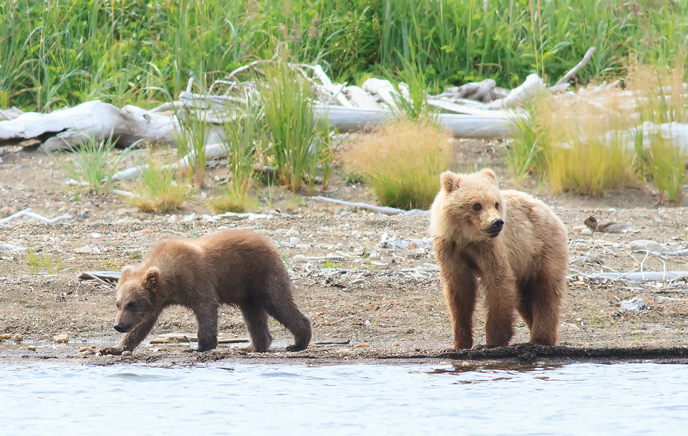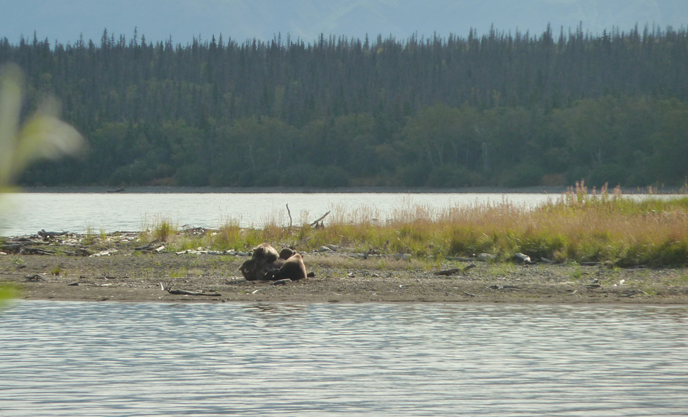
435 Holly and mixed-aged cubs rest at the mouth of the Brooks River. (NPS/M. Fitz)
In early July, bear 402 abandoned her yearling cub. The yearling, then on its own, was seen several more times in July walking along the banks of the Brooks River. Rangers, including myself, were routinely asked, “Will it find another bear to care for it?” My usual response to this question was coldly factual: Adoption of cubs by another bear is very rare. It has been documented, but is unlikely to happen. However, bears, even young bears, are adaptable and smart. They possess the ability to recognize favorable situations and take advantage of them. 402’s abandoned yearling is no exception.
In late July, photos taken at the mouth of Margot Creek, about 10 miles from Brooks River, suggested that the yearling may have found a foster family. These photos were taken by a bearcam fan who was visiting at the time. Several well known Brooks River bears fish along Margot Creek from late July to late August. I was not skeptical of the yearling’s presence at Margot Creek. His biological mother is known to fish there and was seen there last year with her litter in tow. The series of photos, which piqued the interest of rangers and bearcam fans alike, showed the yearling in close proximity to 435 Holly and her spring cub.

435 Holly (left), 402's former yearling, and Holly's spring cub (behind the yearling at right) were all seen together near the mouth of Margot Creek. (Tina Crowe photo)

435 Holly's spring cub and 402's abandoned yearling stand next to one another at Margot Creek. (Tina Crowe photo)
I was unwilling to conclude from these photos that an adoption had occurred. After all, Holly could’ve been merely tolerating the yearling’s close proximity and adoption in brown bears is very rare. Larry Aumiller, the long time manager of McNeil River State Game Sanctuary, observed instances of cub “swapping” where two families of bears come together, the cubs intermingle, and some of the cubs follow the wrong mother. I’ve never seen any adoption of cubs at Brooks River and there is no record of such an event in Katmai’s Brooks River bear monitoring files. However, rare instances have been documented elsewhere, like on Kodiak Island.
I found the photos intriguing though. Could an adoption have occurred? 435 Holly is a bear that routinely returns to the Brooks River in September. I eagerly awaited her return. If she had the yearling in tow, then that would provide firm evidence that she had adopted it. If she was seen nursing the yearling, then there would be no doubt Holly had become an adoptive mom.
Last Friday, 435 Holly returned to the mouth of the Brooks River with her spring cub and the yearling. Since then, the yearling has nuzzled his adoptive mother, taken fish from her, slept with the family, and nursed along side the spring cub.

435 Holly lies on her back while nursing her cubs at the mouth of the Brooks River. (NPS/M. Fitz)
The risks that cubs face are very high, even with a protective mother at their side. The risks that an abandoned or lost cub faces are exceptionally high. Cubs learn where to find food, when food is available, where to den, and a host of other lessons from their mother. Without mom to provide those lessons, nourishing milk, and protection from other animals, a cub is unlikely to survive.
The yearling, by finding a foster mom, proved once again that bears are adaptable. If the reward outweighs a risk, then bears will take a chance. In the yearling’s case, the reward (protection, food) was worth taking the risk (intolerant bear, injury, death). If it had approached an intolerant female it could have been injured or killed.
We don’t know what circumstances brought the yearling and Holly together. Holly is generally tolerant of the close proximity of other bears. Perhaps the yearling stumbled upon her and found she didn’t react defensively. Perhaps the yearling remembered her tolerance from interactions along the Brooks River. Whatever happened, the yearling found the right bear at the right time.
One nagging question keeps revolving in my mind—why would 435 Holly adopt the yearling? Some biologists hypothesize that altruism evolved in some animals is a result of shared genes. If costs to your own fitness are not too great, it would make sense for you to care for your siblings and their offspring because you share genes with them, genes that will be passed on when they reproduce. However, 402 and 435 Holly are not known to be related. Bears also don’t live in social groups like wolves or humans where social pressures often dictate behaviors. Let’s not forget about Holly’s spring cub either. It now faces extra competition from a bigger, stronger bear. Could the adoption of a yearling into the family reduce the spring cub’s chances of survival? Could that decrease Holly’s genetic fitness? Will an extra warm body in the den benefit her and her genetic cub during hibernation?
We will never know Holly’s motivation in this situation. I’ll ponder these questions, even if they don’t have an answer, but adoption is rare in the bear world. The adaptability of bears and the surprises they provide are will motivate me to keep watching and learning.
